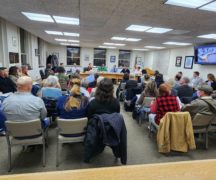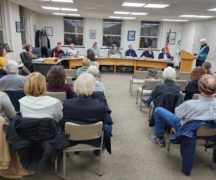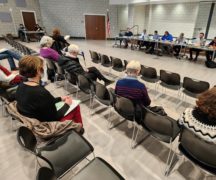There is now a third document to consider in the Revised BG Zoning Code discussion. Written by two members of City Council, Rachel Phipps and Jeff Dennis, in lack of an official name, it will be called the “Phipps-Dennis Plan” below.
The original document was the proposed Zoning Code itself, written by outside consultants, and currently revised by City Council in response to citizen comments. It was this original document that proposed a “Pedestrian-Residential” (PR) district of mixed owner-occupied homes, rental properties, and businesses, reflecting the reality of existing circumstances. To concerned citizens, this original proposal appeared to advocate increasing businesses in the mostly residential area, plus had disturbing language of decreasing lot sizes, increasing residential housing density, covering up to 80% of properties with buildings and parking pads, buildings permitted within 5 feet of sidewalks, and converting single family homes to duplexes. The consultant defended this as part of the “New Urbanism” doctrine, without disclosing that many cities are reversing this trend, turning vacant business properties back into residences.
The second document is a citizen proposal to replace the PR district language in the Revised Zoning Code with a new “Central Residential” (CR) district that emphasizes maintaining the essential residential quality of the existing neighborhoods. Contrary to misinformation given both in letters to the editor and on Facebook, nothing that has been proposed would affect existing businesses in the PR/CR district, nor is there any language about reducing or excluding rental properties. The focus has been, and continues to be, concern about the expansion of new businesses into residential communities. Individuals have spoken to City Council with a certain amount of emotion about dealing with the effects of living next to businesses, such as security lights shining through their windows all night, 4 am dumpster pick-ups, noise, odor from restaurants, litter, increased vehicle traffic, and parking. The worst statement that could be made about the citizens involved in this issue is that they want the City to enforce already existing regulations against irresponsible landlords.
The Phipps-Dennis plan has two components: (1) reducing new business development in the PR district, and (2) removing approximately 30 city blocks from the proposed PR district, reformatting those city blocks as a new mixed-use zone, and having permitted or conditional uses that would be almost identical to the commercial business district. There would be some differences—bars and taverns would be conditional rather than automatically permitted. Automotive sales, refueling stations, and repair stations would not be allowed. But both the commercial district and mixed-use zone would allow hotels, retail sales, rooming or boarding houses, restaurants, professional offices, nursing homes, medical services, etc. And, unlike the commercial district, the proposed mixed-use zone would have one- and two-unit dwellings.
When citizens were first told about the proposed BG Zoning Code, we were told two things: (1) there is a need to simplify the existing zoning code, and (2) there is a need for affordable housing in Bowling Green.
The Phipps-Dennis plan would not simplify the existing zoning code, in fact it would make zoning appreciably more difficult in Bowling Green, with a mosaic of city blocks of competing interests and concerns. The Phipps-Dennis plan would not address concerns about affordable housing at all. Citizen after citizen has spoken to them both personally and at Council meetings about the impact of businesses on degrading residential neighborhoods. Basically, the Phipps-Dennis plan is about allowing designated residential neighborhoods to degrade until these are unacceptable for any use other than commercial. The loss of housing is contrary to the stated goal of addressing a housing crisis.
Citizen research found that 65% of residential housing in Bowling Green are rental properties, an extraordinary high figure even compared to other college towns. The true “affordability” crisis in Bowling Green is because housing is being converted to rentals, removing the source of homes for first-time house buyers. If anything, the City Council should be focused on means and methods to protect owner-occupied housing, as the true endangered species in this town.
The focus on business expansion by Phipps and Dennis is remarkable, given that they have never produced evidence for this need. Bowling Green not only has a thriving downtown business district, it also has significant business districts on North Main, South Main, East Wooster near I-75, East Wooster near Thurstin, West Wooster near Wintergarden, and Poe and Haskins. In addition to over 600 residents opposing the proposed PR district, prominent business leaders have spoken against it. In the face of overwhelming constituent opposition, Phipps and Dennis should reconsider their position on this issue.
Jim Evans
Bowling Green




